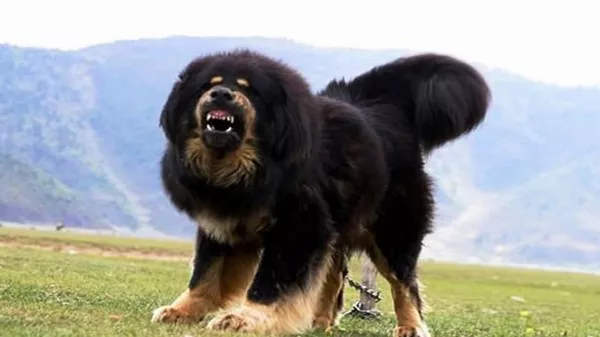The Tibetan Mastiff, with its imposing stature, majestic mane, and unwavering loyalty, has captivated dog enthusiasts for centuries. However, this ancient breed, originally bred to guard livestock and protect against predators in the harsh Tibetan landscape, is not for everyone. While their protective instincts and independent nature are prized by some, these same traits can pose significant challenges for inexperienced owners.
This article delves into the potential downsides of owning a Tibetan Mastiff, providing a comprehensive understanding of the challenges one might encounter with this magnificent but demanding breed.
Temperament and Training: A Will of Their Own
Tibetan Mastiffs are renowned for their independent and stubborn nature. While highly intelligent, they are not necessarily eager to please and can be resistant to training. This independent streak, coupled with their protective instincts, can lead to several challenges:
Dominance and Aggression: Tibetan Mastiffs can be dominant and may challenge their owners for leadership. If not properly socialized and trained from an early age, this dominance can manifest as aggression towards other dogs, animals, or even people.
Territorial Behavior: Bred to guard territory, Tibetan Mastiffs can be fiercely protective of their homes and families. This can lead to excessive barking, growling, and even lunging at strangers or perceived threats.
Difficulty with Obedience Training: Their independent nature can make obedience training a frustrating experience. They require a patient and experienced handler who can establish clear boundaries and provide consistent, positive reinforcement.
Owning a Tibetan Mastiff requires a significant commitment to socialization and training. Enrolling in puppy classes, working with a professional trainer, and providing consistent socialization experiences are crucial for ensuring a well-adjusted and manageable dog.
Grooming and Maintenance: More Than Meets the Eye
The Tibetan Mastiff’s thick double coat, while undeniably beautiful, requires extensive grooming. Their coat sheds heavily twice a year, and regular brushing is essential to prevent matting and tangles. Additionally, their large size and tendency to drool necessitate regular cleaning and maintenance.
Potential owners should be prepared for:
Frequent Brushing: During shedding seasons, daily brushing is recommended to manage the copious amounts of loose fur. This can be a time-consuming and laborious task.
Regular Bathing: While not required frequently, bathing a Tibetan Mastiff can be a challenging task due to their size and thick coat. Professional grooming services may be necessary.
Drool Management: Tibetan Mastiffs are known for excessive drooling. This can require frequent clean-up and may be unappealing to some people.
Owning a Tibetan Mastiff requires a commitment to regular grooming and maintenance. This can be both time-consuming and financially demanding, as professional grooming services may be necessary.
Exercise and Mental Stimulation: Needs Beyond the Backyard
While not overly active, Tibetan Mastiffs require regular exercise and mental stimulation to prevent boredom and destructive behaviors. Their exercise needs may not be met with simple walks around the block.
Potential owners should consider:
Long Walks and Hikes: Tibetan Mastiffs enjoy exploring and require long walks or hikes to expend their energy.
Mental Stimulation: Puzzle toys, chew toys, and training sessions are essential for keeping their minds occupied and preventing boredom-induced destructive behaviors.
See Also:Is the Tibetan Mastiff Allowed in the Philippines?
Limited Off-Leash Activity: Due to their independent nature and potential for prey drive, Tibetan Mastiffs should only be allowed off-leash in secure, fenced-in areas.
Providing adequate exercise and mental stimulation for a Tibetan Mastiff requires time, effort, and access to appropriate spaces.
Health Considerations: Potential for Costly Issues
Tibetan Mastiffs are prone to certain health issues, some of which can be costly to manage. These health concerns include:
Hip and Elbow Dysplasia: These orthopedic conditions can lead to lameness and require expensive surgery to correct.
Eye Problems: Tibetan Mastiffs are susceptible to various eye problems, including entropion, ectropion, and cherry eye, which may require surgical intervention.
Hypothyroidism: This hormonal disorder can lead to weight gain, lethargy, and skin problems, requiring lifelong medication.
Potential owners should be prepared for the possibility of significant veterinary expenses throughout the dog’s life.
Not Ideal for First-Time Owners
The Tibetan Mastiff’s temperament, training needs, grooming requirements, and potential health issues make them unsuitable for first-time dog owners. They require an owner with experience handling large, dominant breeds and the time and resources to dedicate to their training, socialization, and overall care.
Conclusion: A Breed for the Dedicated
The Tibetan Mastiff is a magnificent and loyal breed, but it is not without its challenges. Their independent nature, protective instincts, and demanding care requirements necessitate an experienced and dedicated owner.
Potential owners should carefully consider the downsides discussed before welcoming a Tibetan Mastiff into their home. With proper training, socialization, and commitment, these majestic guardians can become devoted companions, but they are not the right fit for everyone.
Related Topics:
How Tall Is a Chinese Tibetan Mastiff in Feet?
Tibetan Mastiff vs Caucasian Shepherd: Which is Stronger?
Is a Tibetan Mastiff Stronger than a Lion?


























